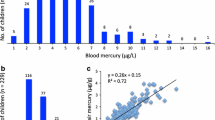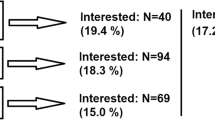Abstract
The intake of lead from the environment may occur thru various receptors. In order to measure lead levels absorbed, samples were taken from Children who live in three localities surrounding an industrial complex in Coatzacoalcos, Veracruz. Samples were also taken from turtles. Samples were analyzed and results were compared against the general population. In children tested, over 75% of all values were determined to be above CDC’s safety levels of (10 μg/dL). The geometric mean lead concentration was 11.4 μg/dL, which is clearly higher around the industrial complex than in the general population. In turtles, lead blood levels in the exposed population were 2-fold above (24.2 μg/dL) those of turtles in the reference population (10.1 μg/dL). Lead levels observed represent a risk for both human and fauna health.


Similar content being viewed by others
References
Ahamed M, Verma S, Kumar A, Siddiqui MKJ (2005) Environmental exposure to lead and its correlation with biochemical indices in children. Sci Total Environ 346:48–55
Altland PD, Brace KC (1962) Red cell life span in the turtle and toad. American J Physiol 203:1188–1190
Arrieta MA, Apartín C, Rosenberg CE, Fink NE, Salibián A (2001) Blood lead content in a peri-urban population of the South American toad Bufo arenarum. Sci Total Environ 271:99–105
ATSDR. Agency for Toxic Substances and Disease Registry (2007) Toxicological profile for lead. p 582
Bergeron JM, Crews D, Mc Lachlan JA (1994) PCBs as environmental estrogens: Turtle sex determination as a biomarker of environmental contamination. Environ. Health Perspect 102:780–786
Bickham JW, Hanks BG, Smolen MJ, Lamb T, Gibbons JW (1988) Flow cytometric analysis of the effects of low-level radiation exposure on natural populations of slider turtles (Pseudemys scripta). Arch Environ Contam Toxicol 17:837–841
Bozada L, Páez M (1986) La fauna acuática del Río Coatzacoalcos. Centro de Ecodesarrollo y Universidad Veracruzana, México
Burger J, Gibbons JW (1998) Trace Elements in Egg Contents and Egg Shells of Slider Turtles (Trachemys scripta) from the Savannah River Site. Arch Environ Contam Toxicol 34:382–386
CDC. Centers for Disease Control (1991) Preventing lead poisoning in young children. US Department of Health and Human Services, Atlanta
Flores J, Albert LA (2004) Environmental lead in Mexico, 1990–2002. Rev Environ Contam Toxicol 181:37–109
Gibbons JW (ed) (1990) The slider turtle. In: Life history and ecology of the slider turtle. Smithsonian Institution Press, Washington, DC, pp 3–18
Laidlaw M, Mielke H, Filippelli G, Jonhson D, Gonzáles C (2005) Seasonality and children’s blood lead levels: Developing a predictive model using climatic variables and blood lead data from Indianapolis, Indiana, Syracuse and New Orleans, Louisiana (USA). Environ Health Perspect 13:793–800
Levin R, Brown MJ, Kashtock ME, Jacobs DE, Whelan EA, Rodman J, Schock MR, Padilla A, Sinks T (2008) Lead Exposures in US Children, 2008: implications for prevention. Environ Health Perspect 116:1285–1293
Lovelette CA, Wright E (1996) In Vivo Effects of Pb+2 Upon 5-Aminolevulinate Dehydratase in T. scripta. Abstract papers. Am Chem Soc 211:90
Meyers-Schöne LL, Walton BT (1994) Turtles as monitors of chemical contaminants in the environment. Rev Environ Contamin Toxicol 135:93–153
Overman SR, Krajicek JJ (1995) Snapping turtles (Chelydra serpentina) as biomonitors of lead contamination of the Big River in Missouri old lead belt. Environ Toxicol Chem 14:689–695
STATISTICA (2001) StatSoft. Version 8.0. StatSoft, Tulsa (OK)
Subramanian KS (1989) Determination of lead in blood by graphite furnace atomic absorption spectrometry-A critique. Sci Total Environ 89:237–250. doi:10.1016/0048-9697(89)90263-5
US EPA. US Environmental Protection Agency (1986) Air quality criteria for lead. http://cfpub.epa.gov/ncea/cfm/recordisplay.cfm?deid=32647. Accessed 11 Jan 2009
Willingham EJ, Crews D (1999) Organismal effects of environmentally relevant pesticide concentrations on the red-eared slider turtle. Gen Comp Endocrinol 113:429–435
Willingham EJ, Crews D (2000) The red-eared slider turtle: an animal model for the study of low doses and mixtures. American Zool 40:421–428
Acknowledgments
This work was supported by a grant from the National Institute of Ecology, SEMARNAT (DGICUR-INE) [No. de convenio INE/A1-047/2007]. We also thank the University of Veracruz, campus Coatzacoalcos. Special thanks to Prof. Jesus Guerrero and Biol. Susan Quackenbush for English language editing of the manuscript.
Author information
Authors and Affiliations
Corresponding author
Rights and permissions
About this article
Cite this article
Pelallo-Martínez, N.A., Ilizaliturri-Hernández, C.A., Espinosa-Reyes, G. et al. Assessment of Exposure to Lead in Humans and Turtles Living in an Industrial Site in Coatzacoalcos Veracruz, Mexico. Bull Environ Contam Toxicol 86, 642–645 (2011). https://doi.org/10.1007/s00128-011-0290-3
Received:
Accepted:
Published:
Issue Date:
DOI: https://doi.org/10.1007/s00128-011-0290-3




